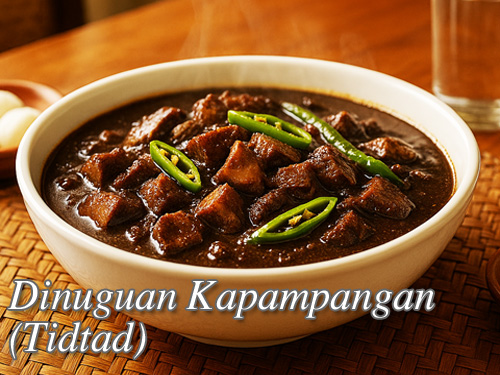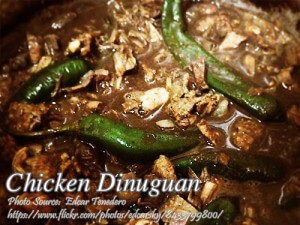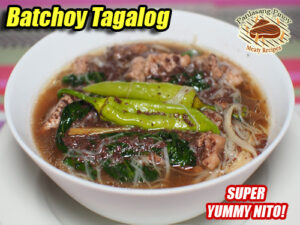This is a recipe of tidtad, a Kapampangan version of the famous pork dinuguan. But unlike the regular dinuguan, this one is saucy and not very thick because it uses less pork blood. In this recipe, we used pork mask which includes the pig ears.
But it contains a lot of fat so there is an option of using leaner parts of the pig like the kasim (pork shoulder). Also you will notice the way this dinuguan is cooked where the pork mask is brown on its own rendered fat to make the dish more appetizing compared with just boiling the pork. It also reduces the fat rendered from the pork mask to make the dish healthier.
Unveiling the Delight: Dinuguan Kapampangan (Tidtad) Recipe
If you’re a fan of hearty Filipino dishes, especially those with a rich and saucy profile, then dinuguan kapampangan, also known as tidtad, is a must-try. This kapampangan version of the classic pork dinuguan brings a unique twist, offering a saucier consistency with less reliance on thickening from pork blood. In this culinary journey, we explore the secrets behind crafting this delectable dish that tantalizes the taste buds and showcases the art of kapampangan cooking.
Choosing the Right Pork Cut: A Matter of Flavor and Texture
In the world of tidtad, the choice of pork cut plays a crucial role in defining the dish’s flavor profile. The traditional use of pork mask, inclusive of pig ears, brings an added layer of richness due to its fat content. However, for those seeking a leaner alternative, opting for pork kasim (shoulder) is a viable option. The versatility in pork selection allows you to tailor the dish to your preferences, whether you crave a hearty, indulgent experience or a lighter, health-conscious meal.
Elevating Flavor: The Art of Browning Pork Mask
The distinction in dinuguan kapampangan lies not only in the choice of pork but also in the meticulous cooking process. Unlike the conventional method of boiling pork, this recipe takes a flavorful detour. The pork mask is first browned in its rendered fat, creating a tantalizing foundation for the entire dish. This step not only enhances the visual appeal of the tidtad but also contributes to a more appetizing and nuanced flavor profile. It’s a small yet impactful detail that sets Kapampangan dinuguan apart.
Crafting the Flavor Base: Sauteing Aromatics to Perfection
Every good dish begins with a fragrant and flavorful base, and dinuguan kapampangan is no exception. Start by heating a tablespoon of cooking oil in a pot over medium heat. Saute garlic until its aroma fills the air, then add onions and continue sauteing until they reach a delightful softness. For an extra kick, season the aromatic mix with pepper – a small touch that can elevate the overall taste of your Tidtad.
Infusing Umami: The Role of Patis and the Porky Symphony
To amplify the savory notes of dinuguan kapampangan, the addition of patis (fish sauce) becomes a pivotal moment in the cooking process. Pouring it into the pot and letting it simmer for half a minute allows the umami flavor to meld with the pork, setting the stage for a mouthwatering culinary symphony. With the pork introduced to the mix, stir-frying ensues until the meat achieves a delectable brown hue, with excess fat removed for a healthier outcome.
Mastering the Tangy Twist: Balancing Vinegar and Water
One of the defining characteristics of any dinuguan is its delightful interplay of sweet and sour flavors. In the case of tidtad, vinegar takes the center stage. Pouring it into the pot and allowing it to simmer for two minutes without stirring creates a robust tanginess that becomes the backbone of the dish. Following this, the introduction of water brings the entire concoction to a boil, transforming it into a flavorful broth that promises to tantalize your taste buds.
Perfecting the Harmony: Seasoning and Simmering to Perfection
Achieving the ideal balance of flavors in dinuguan kapampangan requires careful attention to seasoning. Pepper and finger chilies make their entrance, adding layers of spice to complement the richness of the pork. A gentle simmer for two minutes allows these flavors to meld, culminating in a harmonious blend that dances on the palate. Taste adjustments can be made at this point to ensure the dish meets your personal flavor preferences.
The Blood Symphony: Achieving the Right Consistency
The crowning glory of tidtad lies in the addition of pork blood. Pouring it into the pot and bringing it to a boil without the lid results in a velvety, savory symphony. For those who prefer a touch of sweetness, a hint of sugar can be introduced to balance the dish’s acidity. A final cooking stretch of three minutes ensures that the blood reaches the desired consistency, creating a luscious and indulgent masterpiece ready to be served.
Serving the Culinary Masterpiece: Enjoying Dinuguan Kapampangan
Dinuguan kapampangan, or tidtad, is best enjoyed piping hot, served alongside steaming rice or delectable puto. The saucy consistency, coupled with the interplay of savory, sweet, and tangy flavors, makes this dish a true kapampangan delight. Whether you’re a seasoned cook or a culinary enthusiast eager to explore Filipino cuisine, this recipe offers a rewarding journey into the heart of Kapampangan flavors.
How to Cook Dinuguan Kapampangan (Tidtad)
Ingredients
- 1 1/2 kilo pork mask or pork kasim
- 3 cloves garlic crushed
- 1 medium size onion chopped
- 3 tsp. patis or fish sauce
- 3/4 cup vinegar
- 4 cups water
- 5 pcs siling haba or finger chilies
- 1 cup pork blood
- cooking oil for sauteing
- salt and pepper to taste
- sugar to taste
Instructions
How to cook Dinuguan Kapampangan (Tidtad):
- In a pot, heat a tablespoon of cooking oil in medium heat and saute the garlic until fragrant. Then add the onion and saute until soft. You can also season the onion and garlic with pepper but this is optional.
- Then pour the patis and let it simmer for half a minute then put the pork in the pot. Increase the heat and start stirring the pork.
- Stir fry until the pork is brown and render some of the fat. Remove the fat from the pot and leave just a small amount for the dish.
- Then pour the vinegar in the pot and let it simmer for 2 minutes without stirring. Next is pour the water in the pot and bring to a boil.
- Let it simmer until the pork is tender. Add in the pepper and finger chilies. Simmer again for 2 minutes. Adjust the taste if necessary.
- Then pour the pork blood and bring to a boil without the lid. Add the sugar if the broth is too sour.
- Sugar is for balancing the taste of the vinegar. Cook for another 3 minutes or until the blood is cooked as per your preference. Serve hot with rice or puto.
Notes
Cooking Tips of TidTad Recipe:
1. Choose the Right Pork Cut: Selecting the appropriate pork cut is crucial in crafting the perfect Tidtad. Opt for the indulgent richness of pork mask, including pig ears, for a hearty and flavorful experience. Alternatively, lean towards a lighter version by using pork shoulder (kasim). This choice allows you to tailor the dish to your taste preferences, whether you desire a more robust or health-conscious meal. 2. Master the Browning Technique: The distinctive flavor of Dinuguan Kapampangan hinges on the meticulous browning of pork mask. Instead of the conventional boiling method, brown the pork mask in its own rendered fat. This process not only enhances the visual appeal but also contributes to a more appetizing and nuanced flavor profile. The result is a Tidtad that stands out for its rich and savory depth. 3. Balancing Tanginess and Sweetness: Achieving the perfect balance of sweet and tangy flavors is an art in Tidtad preparation. Carefully adjust the levels of vinegar to infuse a robust tanginess into the dish. Introduce a touch of sugar to counteract any excessive sourness, creating a harmonious blend. This attention to balancing the acidic and sweet elements ensures that your Dinuguan Kapampangan delights the palate with a nuanced and well-rounded taste.Nutrition Notes:
Calorie and other nutrition information is derived from HappyFolks.Com recipe nutrition calculator. The percent daily value (%DV) is based on a daily 2,000 calorie diet.Nutrition Facts:
Amount per Serving:325g, Calories: 383kcal, From fat:213, Total fat:23.6g, Saturated Fat:8.3g, Trans Fat:0.2g, Cholesterol:118mg, Sodium: 301 Total Carbohydrate: 6g, Dietary Fiber: 1g, Sugars: 3g, Protein: 34g, Vitamin A: 8%, Vitamin C: 141%, Calcium: 17%, Iron: 15%






I’m glad I found this tidtad recipe. The ingredients seems simple and there is a healthier option of using lean pork. Thanks again!
Hi Julius, thanks also for visiting this blog and sharing your comment!